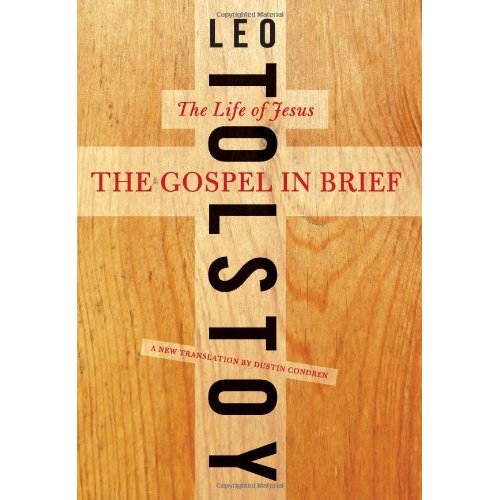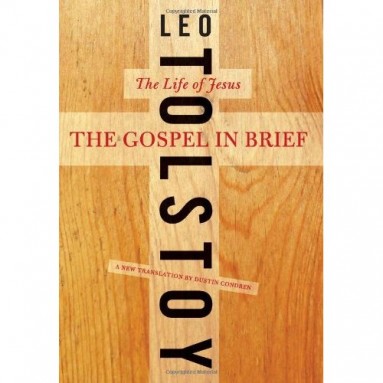The recent publication of Tolstoy’s The Gospel in Brief (in a new translation by Dustin Condren) calls for a renewed investigation of the political, intellectual and religious milieu of 19th century Russia. Since our natural sympathies are generally with Russia’s pro-Western intelligentsia, we mistakenly neglect the fascinating and timely debates about religion and modernity conducted within the group of intellectuals known as the Slavophils.
Tolstoy’s Gospel was first published in 1894, the same year as the coronation of Nicholas II, the last Tsar of Russia. As the Church became aware of the threat western philosophy posed to its influence, it moved to the right and in doing so only pushed the intelligentsia further to the left: towards the materialism, liberalism, and socialism that would ultimately overthrow both Tsar and Church. Tolstoy’s Gospel and the social doctrine it preaches represents the culmination of a century of failed dialogue between the religiously-minded intelligentsia and a church unwilling to adapt or engage with a modern world and a changing Russia. By rewriting the gospels without miracles, a pointed rejection of the Russian Church and the mysticism it embodied, Tolstoy takes a bold step toward the rationalization and secularization of the mystical religion of the Church.
The Gospel in Brief is Tolstoy’s attempt to salvage the beauty of Christ’s teachings from the theological and historical distortions of a Church fixated on the acquisition of temporal power. Tolstoy intended his Gospel to be politically inflammatory; he didn’t even attempt to have it published in Russia. In his Gospel, he substitutes “the orthodox” for the “Pharisees” in the original, drawing a comparison between the Church and those who crucified Christ. As if that weren’t enough, in the preface Tolstoy describes the dogma of the Russian Orthodox Church as “a stinking sack of filth” from which his Gospel seeks to extract the “priceless pearls” buried within. For an intelligentsia still engaged with Christianity in Russia, this is a point of no return: Tolstoy’s writing is no longer in dialogue with the Church, but is an outright rejection of the Church as a valid moral institution.
According to Tolstoy, the teachings of Christ are themselves “the strictest, purest and fullest metaphysical and ethical teaching, above which no other human intellect has ascended to this day in the radiance of which, though it may not do so consciously, all higher human activity operates: political, scientific, poetic and philosophical.” It is important to note that Tolstoy is not seeking to question the divinity of Christ by disregarding the supernatural nor is he hoping to undermine the divinity of his teachings. He is rather interpreting the Gospel as a man of his time might be likely to do, as a rationalistic intellectual endeavor hoping to encounter truth in a “human intellect” in the person of Christ, who “ascended” to a point no human had done before. This statement lays out his project quite clearly and gives us insight into what Tolstoy himself, and the social movement he initiated were up to. Though Thomas Jefferson attempted a similar project a century earlier, he is unique in the way he seeks to locate the divinity of Christ in the coherence of his teachings.
Like many theologians and religious thinkers of his time, Tolstoy sympathized and identified with the pious peasantry of the Russian Christian tradition but differed from them in his rejection of the dogmatic elitism of the institutional Church. In The Other Russian Revolution, Rowan Williams describes the views of Aleksei Khomiakov, the founder of the Slavophil movement:
He’s very much in love with organic imagery and his concept of the church is very much that of the organic community where authority never needs to be exercised because it is always inherent in the very fact of corporate life…in Khomiakov, the Church is reduced to the parish. That is to say the organic local community, the pious peasant commune, is almost indistinguishable from the theological reality of the Church and what is true of the pious peasant commune is all you really need to know about the Church
Reducing the Church to the parish is also Tolstoy’s project in the Gospel. But Tolstoy goes further, indicting the Church as a corrupt institution that detracts from the purity of the pious peasantry. It is Tolstoy’s concern with the practical life, and his conception of the peasant as the highest expression of humanity that ultimately motivates his retelling of the Gospel. He is seeking to “answer the question of life, not the theological or historical question.” How should we live? How do the teachings of Christ shape the practice of life? This is what inspired all those Russian utopians to flock to Tolstoy’s estate at Yasnaya Polyana. They wanted create their heaven on earth, not through the divine grace the institutional church claimed to offer, but through their individual and collective strength.
The Gospel in Brief is book ended by an interpretation of the Gospel of John and the First Epistle of John. Since these do not contain the actual teachings of Christ, Tolstoy adds that his book could do without them, but they do establish two important concepts that are critical in the reading of his Gospel. The first is the correlation between the identity of God and “knowledge of life.” The second is that neighborly love is a manifestation of this knowledge and thus of God. Jesus’ teachings, which comprise the content of the intervening twelve chapters, contain this “knowledge of life,” which Tolstoy ultimately interprets to mean love. This culminates in his depiction of God as a being we must participate in through love in order to acquire knowledge. Knowledge is thus practical rather than theoretical. It is what the Slavophil philosopher and critic Ivan Kireevsky called integral knowledge, a unity between faith and reason in which all human faculties—the physical, the spiritual and the rational—all simultaneously apprehend truth. But Tolstoy is unique among other Russian religious thinkers in that he completely abandons the Church as a place where this kind of knowledge can be practiced.
Along with his rejection of the Church, Tolstoy rejects the dogma of the Holy Spirit. He understands the Holy Ghost as a tool the Church uses to propagate its own ideas, not those of Christ. “To contend that the expression of Dogma is a divine expression, that is, of the Holy Ghost, is the highest degree of pride and stupidity,” he writes. Dismissing the Holy Ghost also entails dismissing the supernatural, which has important implications for his doctrine.
One of the most significant roles the Church occupies in culture is the passing down of tradition. When divinely inspired dogma is the essence of this tradition, a church is indispensable. But when the canonical corpus of the Church is no longer understood to be a divine expression of the Holy Ghost which facilitates the revelation of Christ to the world, then tradition, and the role the Church plays in the passing down of this, becomes obsolete.
He interprets the miracles in the gospel as nothing more than “proof” of Christ’s divinity: “The only value these verses held for Christianity was that they proved the divinity of Jesus for those who did not believe in it.” The supernatural events he does choose to include in his Gospel originate, not in the Holy Ghost, but in the teachings of Jesus to the people. “There is something that proves my teachings—the actions that I teach,” reads Tolstoy’s translation of John 5:36. (The New King James version says, “for the works which the Father has given me to finish—the very works that I do—bear witness of Me, that the Father has sent Me.”) The feeding of the five thousand, which Tolstoy includes, perhaps because it is the only miracle that occurs in all four of the gospels, is what occurs when people practice love through sharing one’s resources. The multiplication of the fish and the bread is no longer a miracle of grace but a simple parable about sharing.
In such a reading, Tolstoy makes common cause with rationalism in order to deny the authority of the Church. By disposing of the Holy Ghost, and in doing so rejecting the Church’s doctrine of Trinitarian love, he locates divinity in moral action rather than in the divine love of God. “The kingdom of God is simply the fulfilling of the father’s will and that the fulfilling of the father’s will depends on the strength of every person,” says Tolstoy’s Jesus. But what The Gospel in Brieffails to articulate, and what is so essential to the message of the canonical gospel is that the “strength of every person” is a gift of grace, a product of a God who condescended to become man, so that man might become God. God’s grace is what makes Tolstoy’s “sharing” possible.
In the Gospel of John, while hanging on the cross, Christ bows his head before giving up his spirit and utters his famous last words, “It is finished”, recalling his earlier elusive statement regarding “the works” the Father had given him to “finish”. The works along with his life are, with his last breath and with his last word, finished. There exists here the culmination of a beautiful motif sustained throughout John’s Gospel: The Word was with God and the Word was God. Christ’s words and his works are his being, there is a perfect unity between who he is, what he does and what he says, and it is this unity of being which bears witness of his divinity (of “the Father”), not the coherence of his teachings.
What Tolstoy’s translation of this passage fails to recognize, and what John is able to so beautifully articulate, is that Christ was not a teacher, a writer, a philosopher, a thinker, a friend or a son. Christ was a person, and that person was God. His teaching is not what needs “proof”, but it is his person, the incarnation, of which his actions bear witness. Tolstoy puts the cart before the horse. “It is done!” his reads, as in fact, his Gospel is. Not only does this version neglect the powerful literary symmetry John creates between what Jesus does and what he says, the Word becoming flesh, but it also leaves us with a dead Jesus and a very different “witness” to contemplate, a witness to actions and teachings that were not enough to conquer death. The beauty of the gospel of John lies in the fact that when it is “finished” (in the Aramaic and Greek the word also means “perfected”) it is not over. Death is not the end; for in Christ’s death, death is conquered and life begins.
If we reduce Christ to his teachings, then they are both failures. A teaching cannot make a bad person good, save the world or eradicate evil. In attempting to discover a teaching that could do these things, Tolstoy was hoping to articulate a path into eternity. Paul Valéry said that “a poem is never complete, it is only abandoned.” Language, like reason, has its limits, and this is something Christ’s resurrection, an event which defies reason, comprehends. Tolstoy wanted what we all want—coherence, understanding, unity, illumination, completion—he wanted language to be enough. What the canonical gospel is trying to tell us is perfectly summed up in the words of Christ in John, “I am the way, the truth and the life.” The truth of Christ is not to be found within the coherence of his teachings; it is to be found in him, in his being, in his person—that person being God. What Tolstoy’s Gospel created was a desacrilized world, one no longer open to the miraculous and the unexplainable, but a world fettered by reason rather than free to explore the great mysteries of faith.

